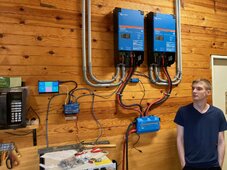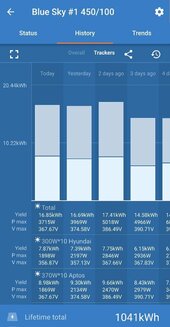Well... Phase 2 is close to wrapping up. I've been vacillating between a minimal "critical load" being run by the inverters vs. a "most of the office" being run by the inverters. Was set on the critical load approach until I rubber ducked the whole system to my daughter over lunch (I know, not the most exciting lunch time conversation!).
So the purpose of Phase 2 was to be a test system prior to implementing Phase 4 (Phase 3 is adding solar to the Phase 2 system), which will likely be 4-8 times as expensive, depending on how Phase 2 and 3 go. To that end, I was looking to build (3) strings of PV arrays - one traditionally south facing at a slant, and two vertical east/west strings (string 1 would have the fronts facing east, string 2 would have the fronts facing west to balance morning and evening efficiency a bit).
Since this is a 48V system, I need 53V to start most MPPT controllers (BV+5V). Given a 25% temp correction for our cold winters, a 250V MPPT will only be able to support 5 panels (60V nominal, ~232V Open Circuit). A 450V MPPT would be able to handle 9 panels in a string (108V nominal, ~417V Open Circuit).
Trying to weigh the pros and cons: 250V is cheaper, (2) of which would provide me (6) string support, 5 panels per string, so up to 30 panels (Hey, that's a pallet load!) for about $1225 plus shipping (excluding panels). But I only really need 3 strings of 9 - still, could do a few extra panels and run (6) strings of 5 panels. Power producing hours would likely be less than 9 panels strings though. Of course, wiring cost would double vs. 450V.
Given a 3 string minimum, 450V means the top-of-the-line Victron (my default so far) MPPT 450/200 at $2155 plus shipping (excluding panels). I'd also have (1) of a component, and rather prefer 2+ to avoid single points of failure. But that is one NICE unit. On the other hand, the Phase 4 project would have several, and it would be nice to gain experience with the exact product being used for Phase 4. Same for dealing with 9 panel strings vs. 5 panel ones. The alternative would be (2) MPPT 450/100s, slightly more expensive at $2462, but eliminates the single point of failure concern and they should otherwise behave the same as the 450/200.
Not 100% locked into Victron MPPT - do need something CAN.bus compatible, and of course, going pure Victron pretty much ensures that. Do want to stick with MPPT devices available from CurrentConnected. For instance, the Midnite Classic 250V, with HyperVOC, could handle an extra panel per string since its really a 298V unit. Behavior would be a bit different, with the units shutting down on the coldest days until the Open Circuit voltage dropped as the day warmed, but that is a rare. The MidNite Hawke's Bay looks interesting, handling up to 12 panels per string if I'm willing to live with ultra cold weather shutdowns. Only two strings, so would need 2, similar to the Victron 450/100 config except with more panel capability (and panels are, lets face it, one of the cheapest parts of the system these days).
Midnights come with a 5 year warranty, didn't spot the warranty period on Victrons?
Thoughts?








